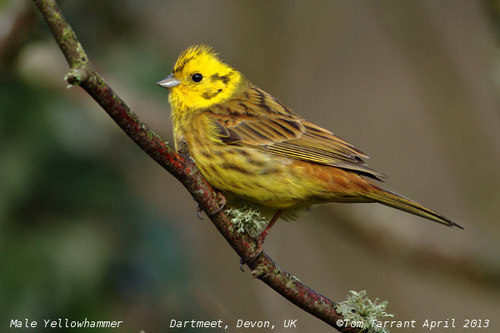
Yellowhammer
The Yellowhammer (Emberiza citrinella) is a striking passerine bird, easily recognizable by the male's bright yellow head and underparts. It plays a crucial role in its ecosystem, primarily as a seed disperser and a consumer of invertebrates, impacting both plant distribution and insect populations. Culturally, the Yellowhammer's distinctive song, often described as "a little bit of bread and no cheese", has made it a familiar and beloved bird in rural landscapes, particularly in Europe. It is a bird often associated with farmland and hedgerows.
15.5-17 cm
Length
23-29.5 cm
Wingspan
Least Concern
Conservation Status
Distribution
The Yellowhammer is native to Eurasia. Its range extends from Ireland and Great Britain eastward across Europe and Russia to central Siberia. It has also been introduced to New Zealand and, to a lesser extent, South Africa. The species is largely resident, although northern populations may migrate south for the winter.
Lifespan
The average lifespan in the wild is around 3 years, but some individuals have been recorded living up to 13 years.
Yellowhammer's Habitat
Habitat Types
Farmland, Hedgerows, Woodland edges, Grassland with scattered shrubs, Heathland
Climate Zones
Temperate, Boreal
Adaptations
Yellowhammers are well-adapted to open habitats with some cover. Their relatively robust beaks are suited for cracking seeds, a staple of their diet. Their coloration provides some camouflage in grassy and shrubby environments.
Variations
Three subspecies are generally recognized: *E. c. citrinella* (western and central Europe), *E. c. erythrogenys* (eastern Europe to central Siberia), and *E. c. caliginosa* (Ireland and Great Britain). These subspecies differ slightly in plumage and size.
Appearance
Breeding Plumage
Breeding males have bright yellow heads and underparts with a chestnut-brown back streaked with black. Non-breeding males are duller, with less yellow and more brown streaking. Females are less brightly colored than males, with more streaking and less yellow.
Seasonal Feather Changes
Plumage is brightest during the breeding season. After breeding, birds molt into a duller, more cryptic plumage.
Sex Based Plumage Differences
Significant. Males are much brighter yellow than females, particularly on the head and breast.
Notable Features
Bright yellow head (in breeding males), Chestnut rump, Streaked brown back, White outer tail feathers (visible in flight)
Diet and Feeding
Primary Foods
Seeds, Grains, Invertebrates (especially during breeding season)
Foraging Behavior
Yellowhammers primarily forage on the ground, often in small flocks. They search for seeds and grains among vegetation and on bare ground. During the breeding season, they also actively hunt for insects and other invertebrates to feed their young.
Specializations
Their relatively stout bill is well-suited for husking seeds.
Seasonal Diet Variations
The diet shifts significantly between seasons. Seeds and grains are the primary food source in winter, while invertebrates become crucial during the breeding season to provide protein for chick growth.
Behavior
Social Structure
Yellowhammers are often found in small flocks outside of the breeding season. During the breeding season, they are more territorial, with males defending their nesting area.
Communication
Distinctive "a little bit of bread and no cheese" song, Various call notes, including a sharp "tsit" and a buzzing "zrrr"
Migration
Most populations are resident or only undertake short-distance movements. Northern populations may migrate south for the winter, but the extent of migration varies depending on the severity of the winter.
Territorial or Group Behaviors
Males are territorial during the breeding season, defending their nesting area against other males. Outside of the breeding season, Yellowhammers often form loose flocks, sometimes mixed with other seed-eating birds.
Conservation
Threats
Agricultural intensification, Loss of hedgerows, Pesticide use, Changes in farming practices (e.g., reduced stubble fields)
Protection Programs
Agri-environment schemes that promote wildlife-friendly farming practices, Hedgerow restoration and management projects
Local National Laws
Protected under various national wildlife legislation in many European countries.
Population Trend
Although listed as Least Concern globally, populations have declined significantly in some parts of Europe, particularly in Western Europe, due to agricultural changes.
Population Estimates
The global population is estimated to be between 40,000,000 and 71,999,999 mature individuals (IUCN).
Interesting Facts
The Yellowhammer's song is a distinctive and easily recognizable sound of the countryside.
It's often transcribed as 'a little bit of bread and no cheese'.
Yellowhammers were introduced to New Zealand in the 1860s.
They have since become widespread and common in that country.
The scientific name *Emberiza citrinella* refers to the bird's yellow color.
'Citrinella' is derived from the Latin word 'citrinus', meaning lemon-yellow.
The collective noun for a group of Yellowhammers is a 'party'.
Faqs about Yellowhammer
What do Yellowhammers eat?
They primarily eat seeds and grains, but also feed on insects, especially during the breeding season.
Where do Yellowhammers nest?
They build cup-shaped nests low down in vegetation, such as hedgerows, thick grass, or at the base of shrubs.
Are Yellowhammers endangered?
They are currently classified as Least Concern by the IUCN, but populations have declined in some areas due to habitat loss and changes in agricultural practices.
What is the difference between a male and female Yellowhammer?
The males have a vibrant yellow head and are generally brighter than the more camouflaged females.
Copyright @ Nature Style Limited. All Rights Reserved.
 English
English